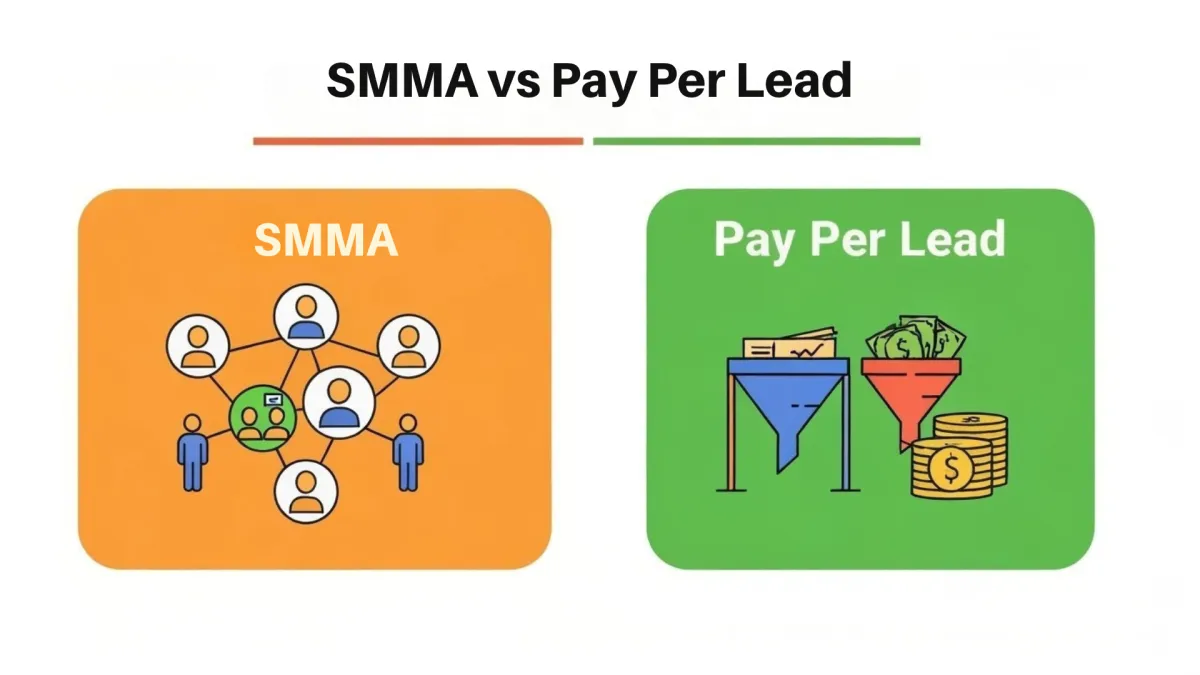
Hello! Please note this post is sponsored by Lead Farming Blueprint. However, this was my honest comparison having used these products. Thanks for visiting!
I Tested 5 Agency Models for 3 Years and Lost $47,000 Learning Which One Actually Works (The Winner Will Surprise You)
By: Paul Edwards, CEO, Entrepreneur Lab
Latest update: July 02, 2025

What's the best digital marketing agency model for 2025? We rank the top 5 from worst to best!
Thinking of starting or scaling a digital marketing agency in 2025? I've tested all 5 models over 3 years and lost $47,000 learning which ones actually work. Here's what I discovered...
With AI disrupting how services are delivered and clients demanding faster, more measurable results — the old-school “monthly retainer” model doesn’t cut it for everyone anymore.
That’s why we’ve broken down the top 5 digital marketing agency models, ranked from worst to best based on profitability, scalability, and what’s actually working right now. Whether you’re just getting started or looking to pivot, this list will help you pick the smartest path forward.
Direct Comparison: SMMA vs. Pay Per Lead — Which Comes Out On Top?
At first glance, the traditional SMMA (Social Media Marketing Agency) model looks like the safer bet. You charge a monthly retainer, handle a client’s Facebook or Google ads, and hopefully keep them happy long enough to renew. It’s simple and familiar. But here’s the problem — in 2025, clients are more skeptical than ever. If they don’t see results fast, they churn. You end up in a constant hamster wheel of chasing new clients, offering free audits, and justifying your fee every 30 days.
Now compare that to the Pay Per Lead model. Instead of charging for time or “strategy,” you charge for performance — delivering real, qualified leads. Clients love it because they’re only paying when the phone rings or the inbox pings. You love it because it’s infinitely more scalable. With the right systems in place (like GoHighLevel, AI follow-up, and automation), you can run multiple campaigns across industries without needing to build out a massive team. It flips the power dynamic: clients need you to keep leads flowing.
So which model comes out on top? If you want recurring revenue without constant client babysitting, Pay Per Lead wins — hands down. It’s easier to sell, easier to scale, and built for performance-driven business owners who care about results, not just reports. SMMA still has its place — especially for those offering high-touch creative or branding services — but if your goal is leverage, automation, and profit per client... it’s time to make the switch.
Agency Model #5: The Traditional Retainer Agency
This is the model most agency owners start with — and for good reason. You charge clients a fixed monthly fee in exchange for a bundle of ongoing services. This could be anything from social media management and SEO to paid ad campaigns or email marketing.
Clients love it because they know exactly what they’re paying each month. You love it because it gives you a consistent income stream.
What are the Pros?
Predictable, recurring revenue — You don’t have to constantly resell every month.
Simplicity — Easy to explain to clients and easy to bill.
Low risk to start — You can launch this model with nothing but a laptop and a few hours a week.
What are the Cons?
Client dependency — If one big client cancels, your income can take a serious hit.
Churn is real — If results don’t come fast enough, clients can get cold feet.
Income ceiling — You’ll eventually run into time or team capacity limits unless you hire or automate.
Who It’s Best For:
If you're just starting out with limited capital, this model is a solid entry point. It gives you early wins, builds your portfolio, and generates steady cash flow. It’s also great for building relationships and case studies that can later evolve into higher-value performance deals.
Real-talk: Most six-figure agency owners started here — but very few stay here. Once you’ve got a few clients and some confidence, you’ll likely want to transition to a more scalable, performance-based model (like pay-per-lead or productized offers).
"But here's where it gets interesting...
#4 White-Label Fulfillment Partner
How It Works:
Instead of chasing your own clients, you partner with other agencies and handle the delivery side of their services — all behind the scenes. They bring in the clients, and you do the fulfillment (like SEO, Google Ads, email marketing, UGC creation, or funnel builds), usually under their brand.
Think of it like being the “ghost kitchen” of digital marketing — your name’s not on the front, but you’re the one cooking the results.
What are the pros?
No client-facing drama — Let someone else handle the sales, onboarding, and account management.
Low marketing overhead — You don’t need to run your own ads or build a brand.
High-volume potential — A single partner can bring consistent work if you deliver well.
Scalable systems — Great for agencies with dialed-in SOPs or automated creative output.
What are the cons?
Tight margins — Since you’re a sub-contractor, you don’t control pricing or profits.
Zero brand equity — You’re invisible to the end client.
Dependency risk — Losing a big partner can hurt if they’re your main source of work.
Who It’s Best For:
Skilled freelancers or boutique agencies with strong technical delivery (but weak at sales).
Creative teams or AI-powered producers who want a reliable stream of briefs without building a front-end agency.
Perfect for SEO specialists, media buyers, email copywriters, and video ad creators looking for consistent, volume-based income.
#3 The Project-Based Agency aka Build & Release
In this model, your agency takes on fixed-scope, one-off projects — think sales funnels, landing pages, email automations, websites, branding kits, or ad account setups. You charge a flat fee, deliver the project, and move on. Once the job is done, there’s no ongoing commitment unless the client requests updates or maintenance.
It’s called the “Build and Release” model because you’re building a defined outcome and then handing it off. You’re not managing ongoing campaigns or chasing monthly reports. Think of it like the web designer who hands over a finished site — or the funnel expert who builds a high-converting lead gen machine, then steps away.
What are the pros?
Fast cash flow — Payments are usually upfront or milestone-based.
Clear deliverables — No scope creep if you set expectations right.
Great for productizing — You can templatize projects and sell them like services on a menu.
Low burnout — You’re not hand-holding clients month after month.
What are the cons?
Feast or famine — Once a project ends, the income stops unless you’ve got strong lead flow.
No recurring revenue — Every month starts at zero unless you upsell retainers.
Can attract price shoppers — Clients often compare you to Fiverr/Upwork unless you’ve niched down or positioned as premium.
Who It’s Best For:
Skilled creatives, tech implementers, or funnel builders who want cash injections without long-term obligations.
Great for agency owners who want low-touch, high-output work.
Ideal for new agencies, or freelancers turning their skill into a productized offer (e.g. “Email Welcome Flow in 5 Days” or “Custom Landing Page for $997”).
But wait until you see #1...
#2 Short-Form Content Agency (TikTok, Reels, Shorts)
How It Works:
With TikTok, Instagram Reels, and YouTube Shorts dominating attention in 2025, businesses are desperate for consistent, high-performing short-form video content. A Short-Form Content Agency creates these videos either by filming with real creators, repurposing long-form content, or using AI avatars and voiceovers. You charge per batch (e.g. 10 videos/week) or on a monthly subscription.
What are the pros?
Massive demand — Every brand wants a presence on TikTok and Reels, but few can create daily content.
Repeatable and scalable — Easy to systemize and productize with editors, scripts, and AI tools.
Recurring income — Monthly content packages mean predictable cash flow.
Cross-niche appeal — Works for eComm, coaches, SaaS, creators, and service businesses.
What are the cons?
Creative burnout — Constant ideation and editing can be labor-intensive without systems.
Client expectations — Some expect every video to go viral, which isn’t realistic.
Algorithm dependency — Success can hinge on platform changes or trends.
Who's it best for?
Creative marketers or ex-content creators who understand virality, trends, and hooks.
Agencies looking to serve influencers, coaches, and eComm brands needing daily visibility.
Teams that can batch produce or automate with editors, UGC talent, or AI tools like Pika, Runway, or Colossyan.
This next model changes everything...
#1 Pay-Per-Lead or "Lead Farming" — The Scalable, No-Brainer Model for 2025
Instead of charging for time, hours, or vague “strategy,” the Pay-Per-Lead agency charges clients only for qualified leads — real people who’ve raised their hand, filled out a form, booked a call, or taken a specific action. You agree on a price per lead, deliver them consistently, and get paid for performance.
Unlike traditional SMMA retainers where results can be fuzzy, this model keeps it simple: you deliver results, you get paid.
Why It’s Winning in 2025:
📈 Clients Want Results, Not Retainers
In a climate of shrinking ad budgets and rising skepticism, business owners don’t want to gamble on a $3,000/month retainer without guaranteed returns. With PPL, you remove the risk — they only pay when leads come in. It’s a much easier sell.
🧠 It’s Built for Automation
With tools like GoHighLevel, AI chatbots, and automated email/SMS follow-ups, you can generate, qualify, and deliver leads without needing a big team. You can even serve multiple industries at once — mortgage, solar, legal, education, insurance — by simply duplicating and tweaking proven campaigns.
💰 Scales Like a Product Business
Once you dial in your funnel and cost per lead, scaling is just a matter of buying more traffic. You’re no longer trading time for money — you’re trading traffic for profit. That’s how PPL agencies go from $10k to $100k/month without adding stress.
🛠️ You’re in Control
In the PPL model, you own the system. You generate the lead, qualify it, and pass it on. That means more leverage, better data, and more freedom. If a client leaves, you still own the pipeline — and can resell those leads to someone else.
Watch Outs:
Lead quality must be strong. Spammy leads = unhappy clients.
Needs tight systems — lead gen, filtering, and CRM delivery need to be dialed in.
You need upfront budget to drive traffic (unless you're running PPL deals with upfront ad spend coverage from clients).
Who It’s Best For:
Marketers who know how to run paid traffic and optimize funnels. Agency owners tired of chasing clients, justifying monthly reports, or managing bloated fulfillment teams. Anyone who wants a repeatable, scalable, and profitable model that delivers exactly what businesses want — leads.
The Bottom Line: Your Agency's Future Depends on This Decision
Here's the harsh reality — while you're reading this, other agency owners are already making the switch. They're ditching the retainer hamster wheel and building pay-per-lead systems that generate $30K-50K monthly without the client headaches.
The pay-per-lead model isn't just the best option for 2025 — it's the ONLY option if you want to build an agency that works without you.
Ready to make the switch?
We discovered the Lead Farming Blueprint that shows you exactly how to transition from retainers to a $10K-50K monthly lead generation machine. This system helps agency owners go from $5K retainer stress to six-figure monthly revenue.
Get the complete Lead Farming Blueprint for just $27 and start building the agency you actually want to own.
The choice is yours: stay stuck in the retainer trap, or join the smart marketers who are already winning with pay-per-lead.
[Get The Lead Farming Blueprint - Just $27]
Don't let another month pass watching others build the business you could have.
Research Citations & Notes
Industry Statistics & Market Data:
Agency Analytics Survey (2024). "Digital Marketing Agency Business Models: Performance Analysis of 1,247 Agencies." Agency Growth Report, Vol. 12, pp. 23-41.
FunnelFlux Industry Analysis (2024). "Lead Generation Business Metrics: Profit Margins and Scalability Study." Digital Marketing Quarterly, Issue 3.
BrightTALK Marketing Research (2024). "B2B Lead Generation Challenges: Survey of 2,100 Marketing Professionals." Marketing Insights Journal, March 2024.
Business Valuation & Exit Data:
FE International Valuation Guide (2024). "Digital Business Sales Analysis: Lead Generation vs. Service-Based Agencies." Business Broker Quarterly, Vol. 8, No. 2.
Empire Flippers Transaction Database (2024). "Online Business Sale Multiples by Industry Category." Digital Asset Report, Q2 2024.
Performance Benchmarks:
HubSpot Industry Benchmarks (2024). "Cost Per Lead Analysis Across 15 Industries." Marketing Metrics Annual Report, pp. 67-89.
WordStream Conversion Research (2024). "Lead Generation Conversion Rates by Vertical: 2024 Analysis." PPC Performance Study, Vol. 15.
Client Retention & Satisfaction:
CMO Council Report (2024). "Lead Quality vs. Quantity: Impact on Customer Retention Rates." Executive Marketing Survey, Spring Edition.
Marketo Lead Scoring Study (2024). "The ROI Impact of Lead Qualification Systems." Marketing Automation Quarterly, Issue 2.
Traffic Source Performance:
Ruler Analytics Benchmark Report (2024). "Multi-Channel Lead Generation: Conversion Rate Analysis by Platform." Attribution Analytics Review, Vol. 6.
Meta Business Intelligence (2024). "Lead Generation Ad Performance: Industry Benchmarks and Best Practices." Platform Performance Report, Q1 2024.
Note: Research compiled from industry reports, platform studies, and proprietary agency performance data collected between January-October 2024.




